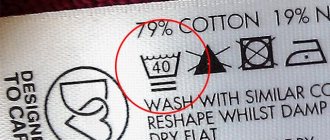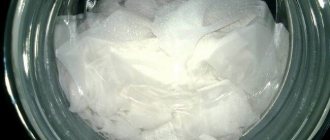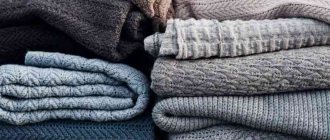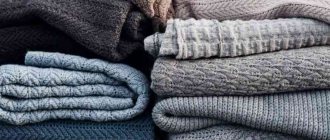When remembering woolen socks, the imagination involuntarily draws the image of a grandmother who carefully knitted them for her beloved grandchildren. Although today not only grandmothers knit, wool products are highly valued for their qualities of naturalness, heat preservation, variety of colors and patterns. Even factory-made pure woolen socks are not inferior in comfort and coziness to handmade products.
Having such a natural pair of footwear in your wardrobe, the question of care immediately arises: how to wash wool socks so that such a procedure does not turn them into a dense lump of wool that has lost its shape, so that they do not shrink or stretch.
Comfortable, warm and practical wool socks
Preparing for washing
Before washing wool socks, do the following:
- Turn over and shake out each item. Dust and small specks will fall out - this will help in washing.
- Manually remove pellets, hair and stuck debris. It's better to use your fingers to avoid damaging the hair with scissors.
- Multi-colored socks should be sorted and washed separately, otherwise they will fade. It is also better to separate light ones from dark ones.
If your socks are very dirty, you may want to soak them briefly. They do this:
- Pour 5 liters of water into a bowl. Temperature - about 30 °C.
- Add 10-15 ml of washing gel (liquid powder) or regular shampoo to the water. Sometimes it is replaced with grated laundry soap (no more than 10 g).
- Additionally, you can add 2 tbsp. l. wool conditioner (Lenor, Neutrale, Sansin) or table vinegar (9%) - this provides better protection for wool fibers.
- Leave for 15 minutes.
After these procedures, begin washing.
Machine washable
Typing your socks by machine, although not recommended, is still acceptable. It is important to create the right conditions for the automatic procedure.
A liquid product specially designed for automatic washing of wool is poured into the appropriate compartment.
If the programs offered by the machine contain the “Wool” mode, you must select it. Otherwise, the delicate mode with the spin option turned off will do. Intense rotation of the drum will only render the item being washed unusable, since in such conditions it can simply shrink and bunch up into a dense lump. In addition, you will need to find out whether there is pre-heating of the water in order to prevent differences in temperatures.
White socks with deer
After the automatic wash cycle, the socks are left in the drum for 4-5 minutes to allow the water to drain. After getting wet with a dry terry towel, the products require drying.
Important! It is not advisable to place wool with long pile for washing in a washing machine. Fibers can become clogged in the drum or clog the washing aid filters. It is advisable to entrust such socks to professional dry cleaners or choose a manual cleaning method.
Washing in a washing machine
Any “washing machine” that supports a choice of washing modes and temperature settings is well suited for woolen products.
How to wash socks in a machine:
- Turn inside out. In case of minor damage, they will be on the inside, and the appearance of the socks will not be affected.
- Place in a mesh bag for washing. Optional, but reduces the risk of fabric stretching.
- Pour in detergent and select a mode (more on this later).
- Start the wash.
- When finished, take out the socks and place them in a basin or on a terry towel to drain.
What is the best detergent to wash?
You need to add the following products to the washing machine:
- washing gel (can be replaced with regular powder, but liquid is better - it is more gentle on wool);
- conditioner for woolen fabrics (can be replaced with regular conditioner, labeled “for delicate items”).
If the labels of chemical products do not indicate how much to add when washing wool, take 1 capful of each. This “standard” volume will be enough for 1-3 pairs of socks.
Which washing mode to choose
If the “washing machine” has a manual temperature input, then it is set to 30 °C. And socks not made from pure wool (with the addition of cotton and synthetics) can also be washed in warmer water - up to 40°C.
It is best to choose “Wool” from the modes (if the machine interface is in a foreign language - wool or wolle). It takes into account the correct water temperature (30 °C) and the appropriate washing time. When there is no such mode, then choose any of the following:
- delicate;
- manual.
It is also worth turning off the spinning and drying functions, which are harmful to wool.
Preparatory stage
Woolen socks can be worn for 3-5 days, and after that you must change a pair. But you can’t wash the products right away. First you need to sort them and separate the dark ones from the light ones to prevent molting. After sorting, remove dirt, pellets, animal hair and threads.
White woolen socks that have darkened from wear can be saved with oxygen bleach or using a folk recipe with a 3% peroxide solution. We use the industrial product according to the instructions, and with the pharmaceutical product we proceed as follows:
- Pour peroxide into warm water at the rate of 30 ml per liter.
- Immerse your socks in it so that they are completely covered, otherwise stains will appear on the uncovered areas.
- Soak for half an hour, turning the product over from time to time.
It is easier to wash very dirty colored socks by soaking. Dilute liquid soap, shampoo or laundry soap shavings in warm water and soak the product in this solution for 15 to 20 minutes. Additional soaping, especially of the soles, will be useful.
Is it possible to wash wool socks with panties?
It is not recommended to combine wool socks with underwear due to the mismatch in temperature conditions:
- to completely destroy germs and viruses on panties, the water temperature must be at least 60 °C - too much for wool;
- Washing panties at 30°C does not completely eliminate the smell of dirty laundry.
But combining socks and panties is still acceptable. You must first soak the laundry in hot water (80 °C) for 20 minutes, and then let it cool. Most germs are killed and the panties can be washed with socks at a low temperature.
What to consider when washing white socks
White wool, like any white fabric, requires a special approach:
- It is better to resort to special bleaches for wool. They protect the item from deformation and give it softness.
- Before washing, soak items in bleach for 15–25 minutes.
- Thoroughly rub the foot area with laundry soap on the outside and inside.
There are many folk recipes for washing white clothes. They involve the use of household substances such as salt, boric acid, ammonia, hydrogen peroxide, starch.
How to wash by hand
Wash socks by hand like this:
- Fill a basin with 5 to 10 liters of water (depending on the number of pairs of socks) at a temperature of 30 °C. It is better to use a thermometer, but you can also determine by touch - if your hands are warm, then the liquid should feel slightly cool.
- Dilute 15-20 ml of liquid powder in water. If you don’t have it, shampoo in the same amount will do.
- If the socks are colored, add 1 tsp. vinegar (9% solution).
- Wash with gentle “crushing” movements, do not rub or squeeze too hard.
- Rinse in water (same 30 °C). You can add 1 cap of conditioner to it.
- Transfer to a dry bowl to drain.
Traditional care
The most gentle and gentle way to remove dirt from wool socks is to wash them by hand. This way the hostess will be able to fully control the process and take into account all the prohibitions. After hand washing, the products will not fade or lose shape. The algorithm of actions will be as follows:
- Fill the basin with water at a temperature of 20-30°C. In a cool environment, wool does not shrink;
- add detergent to the container. You can use shavings of baby or laundry soap, or use special gels for washing wool. It is better to avoid dry powder - its granules do not dissolve well in cold water and are difficult to wash out of fabric fibers;
- soak heavily soiled socks for literally 5 minutes in a soapy solution, this will soak the stains and make them come off easier;
- Rub local stains with soap;
- Using gentle kneading movements, wash the socks first from the outside, then from the inside. There is no need to rub the item forcefully;
- Rinse the products several times, constantly changing the water. You can use a softening conditioner at this stage;
- do not twist the wool. To squeeze out excess water, simply roll up the sock and apply light pressure.
The duration of hand washing should not exceed 30 minutes; the less woolen socks come into contact with water, the better.
To prevent the wool from losing color, you can add acetic acid to the washing solution. For five liters of liquid, add 2 tablespoons of 9% vinegar. Next, the socks need to be dried properly. In a well-ventilated room, on a table, you should spread a towel or sheet and place the products on top. As the bedding gets wet, the socks need to be shifted and turned over.
How to remove an unpleasant odor
There are 2 effective ways to remove odors from wool fabric. They should be applied right before washing:
- Dilute acetic essence or citric acid in cool water. Proportions - 3-4 tsp. products for 1 liter of water. Soak the socks until they are completely immersed in the liquid and leave for 20-30 minutes.
- Turn the socks inside out and wet them (you can use a cold tap). Lather the inside with laundry soap (72%) and leave for 30 minutes. There is no need to rinse - you can wash it right away. This method is not suitable for bright colors - laundry soap makes them fade.
How to wash by hand?
The method is recommended for delicate items made of sheep wool that require special handling .
This type of washing helps save lint, and during it it is easy to see whether the sock is fading or not. The best results are achieved when using soft water. If it is hard or there is a possibility of the pile becoming coarse due to contact with detergents, then wash and rinse with vinegar. The concentration of the essence should not be high. 1-2 spoons per 5 liters of water is enough.
Important! Vinegar not only helps prevent wool socks from becoming rough, but also partially solves the problem of discoloration. Thanks to him, the item sheds less.
During washing, do not use available cleaning agents: clothes brushes, boards . In some cases, resort to a toothbrush. However, this measure is considered a last resort. If you can do without it, it is better not to take risks and not injure the pile.
Other useful notes:
- the total duration of the procedure should not exceed 40–50 minutes;
- To prevent the water from cooling down, you will have to periodically add new water;
- wash not only from the outside, but also from the inside;
- rinse in several stages and at each stage use new, but not running water (do not put the sock under the running tap, but rinse in a basin);
- You can't twist the thing.
At the end of the procedure, socks made from expensive wool are not wrung out . To make the water run away faster, they are rolled into tubes on a pre-spread towel. While wrapping, you need to apply a little pressure to the item.
How to dry socks
Woolen products are not recommended:
- hang on a rope - wet wool becomes very heavy and stretches from its own weight;
- put on a heated radiator - the material becomes rougher from such proximity;
- place on a fan and dry with a hairdryer;
- expose to sunlight.
Dry wool socks horizontally, in a basin or on a terry towel that does not shed. Ventilation in the room helps dry the wool faster and preserves the pleasant smell of the detergent.
Additional Tips
A few tips to help extend the life of wool socks:
- You can buy a device for removing pellets. It is more convenient than picking with your fingers.
- Socks should not be hung vertically; they should be stored in a drawer or on a shelf, folded in half.
- A drawer with socks cannot be filled to capacity, otherwise the wool will wrinkle.
- Before putting them on, it is advisable to air out the socks - turn them inside out and shake them.
- Tablets and sachets with scents of lavender, citrus and chestnut help protect products from moths.











